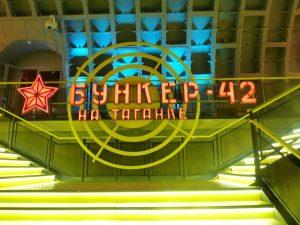 I am early for the tour and am made to wait in the entrance hall. At least I am out of the snow, although it’s colder inside than it was outside. Exactly on schedule, I am ushered in for a security check and then taken back to the cold entrance room for an introduction.
I am early for the tour and am made to wait in the entrance hall. At least I am out of the snow, although it’s colder inside than it was outside. Exactly on schedule, I am ushered in for a security check and then taken back to the cold entrance room for an introduction.
Sasha, a youthful but stern 20-something, is my guide. His English leaves much to be desired and he speaks in a loud, military-style voice that seems appropriate for this place. I concentrate hard to understand him.
The bunker is housed in the mock shell of a well-to-do dwelling.
The house is a ruse to hide the underground military control bunker built for Russian leaders in the event of a nuclear attack. Construction of the bunker began in 1951 in total secrecy, and there are four main tunnels, ancillary tunnels for equipment and stores, and various entrances to the metro system. Sasha shows me the huge concrete double doors.
The complex was built 60 meters below ground in order to withstand an attack on the same level as Hiroshima.
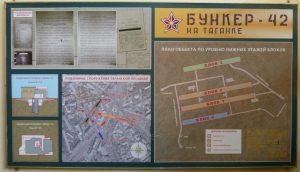 Sasha leads me down the concrete staircase, 18 floors and 60 meters beneath the surface to the tunnels, rushing down so quickly I struggle to keep up. At the bottom, he waits only moments then is off again along one of the tunnels leading to the conference room. He waits for me again and I arrive out of breath. He starts a film for me, which documents the history and horrors of the Cold War years leading up the creation of the bunker. It’s incredible. The story begins when Russia was allies with the U.S. and the U.K. against Hitler’s Germany. It’s uncomfortable to watch the atrocities shown on screen as well as confusing, as it’s in Russian with English subtitles and the story is told from a Russian perspective.
Sasha leads me down the concrete staircase, 18 floors and 60 meters beneath the surface to the tunnels, rushing down so quickly I struggle to keep up. At the bottom, he waits only moments then is off again along one of the tunnels leading to the conference room. He waits for me again and I arrive out of breath. He starts a film for me, which documents the history and horrors of the Cold War years leading up the creation of the bunker. It’s incredible. The story begins when Russia was allies with the U.S. and the U.K. against Hitler’s Germany. It’s uncomfortable to watch the atrocities shown on screen as well as confusing, as it’s in Russian with English subtitles and the story is told from a Russian perspective.
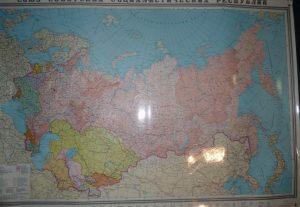 My mind is still reeling when the film ends and Sasha rushes me into the next room — the central control room. It takes a lot of concentration to listen to him because of his poor English — weapon is pronounced (appropriately) “weep on” and bomb and bomber with the second “b” wrongly enunciated. On the wall is a large map of the world, as it looked then, with Russia directly in the center. The room, of course, has no natural light and is only dimly lit.
My mind is still reeling when the film ends and Sasha rushes me into the next room — the central control room. It takes a lot of concentration to listen to him because of his poor English — weapon is pronounced (appropriately) “weep on” and bomb and bomber with the second “b” wrongly enunciated. On the wall is a large map of the world, as it looked then, with Russia directly in the center. The room, of course, has no natural light and is only dimly lit.
Before I realize it, I find myself sitting next to Sasha at one of the control stations.
Sasha is even more animated now and has switched on the panel in front of me and is putting a set of keys into his. He points to the dark green radar screen above us and I hear him say, “Our anti-missile defence is being activated and it is time to respond.” Radar beeps loudly on the screen above us. I suddenly realize he wants the two of us to simulate setting off an atomic bomb. He’s pointing to two switches and urging me to press them. I know this is not real but I stand up and refuse. He’s shocked and says that it’s only a demonstration. I reaffirm that I don’t want to partake in his simulation.
A strange silence fills the room.
After a few minutes, I tell him to continue with the tour but I’m still very unsettled and close to tears as we move into the next room. The whole thing is bizarre. Sasha shows me gas masks, uniforms, and guns, and points to other paraphernalia from the Cold War, like typewriters, phones, and government documents. He says I can touch anything and can even pose for a photograph at the officer’s desk holding a gun or wearing a gas mask. This is very, very bizarre. I tell him we should move on and get to the end of the tour quickly.
Regardless of which side, if any, you are on, this place demonstrates mankind at his worst. Is it the fear of what one side can do to the other that creates places like this? Is this what leads to the creation of monstrous weapons of war and the desire to put a man into space?
 On the way out, Sasha insists I see a simulation of the lockdown of the bunker. Within 10 hours, the bunker could become self-sufficient for five thousand people for 30 days. We walk past the entertainment area, with a karaoke bar and restaurant. Sasha tells me that if an officer was caught sneaking a woman into the bunker, he would be sent to solitary confinement. Although, he says, there are many stories of women who were smuggled in.
On the way out, Sasha insists I see a simulation of the lockdown of the bunker. Within 10 hours, the bunker could become self-sufficient for five thousand people for 30 days. We walk past the entertainment area, with a karaoke bar and restaurant. Sasha tells me that if an officer was caught sneaking a woman into the bunker, he would be sent to solitary confinement. Although, he says, there are many stories of women who were smuggled in.
Thankfully the tour is over and we take the lift back to the surface. I am exhausted both by the nature of the place and the pace of Sasha’s tour. When I ask, Sasha tells me he’s worked here for two years and has often led as many as 14 tours a day. I politely suggest he should consider changing jobs soon.
Before my departure, Sasha comments that the tour is just our history and we shouldn’t be ashamed or concerned. I beg to differ.
Outside, appropriately enough, the bright blue sky of the morning has turned to gray and the snow continues to fall. I had planned to see some of the metro stations, which are renowned for their architecture and design, so I visit a couple of the stations, but decide I need some air rather than staying underground and I head to Gorky Park. I need to be outside.
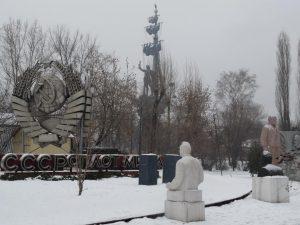 I walk through Sculpture Park, where old communist statues from all around Moscow now stand, away from their previous locations but not yet destroyed. There are statues of Stalin and Lenin and old ‘CCCP’ signs that now sit haphazardly around the park, in front of the huge ‘Peter Columbus’ monument. Apparently the locals call it this because the monument was originally supposed to be Christopher Columbus, but an American buyer could not be found. Zurab Tsereteli, the artist, turned Columbus into Peter the Great and the monument was placed on an island in the middle of the Moskva River, where it now overlooks the other disgraced statues.
I walk through Sculpture Park, where old communist statues from all around Moscow now stand, away from their previous locations but not yet destroyed. There are statues of Stalin and Lenin and old ‘CCCP’ signs that now sit haphazardly around the park, in front of the huge ‘Peter Columbus’ monument. Apparently the locals call it this because the monument was originally supposed to be Christopher Columbus, but an American buyer could not be found. Zurab Tsereteli, the artist, turned Columbus into Peter the Great and the monument was placed on an island in the middle of the Moskva River, where it now overlooks the other disgraced statues.
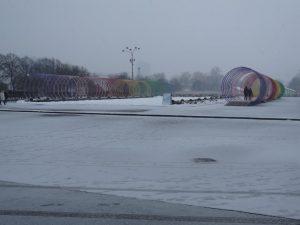 Across the road, I enter Gorky Park through its giant gateway in the heavy snow. Rainbow coloured neon walkways welcome me and I wander past the deserted restaurants and cafés. The park is busy in the summer months and I can imagine it green and full of happy people. But today it’s miserable, cold, and empty, covered in snow under a gray sky.
Across the road, I enter Gorky Park through its giant gateway in the heavy snow. Rainbow coloured neon walkways welcome me and I wander past the deserted restaurants and cafés. The park is busy in the summer months and I can imagine it green and full of happy people. But today it’s miserable, cold, and empty, covered in snow under a gray sky.
The snow gets thicker as it falls harder, but I’m glad I’m outside and no longer in Tagansky Bunker.
(c) 2017 Pete Martin. This article is an adapted excerpt from Pete Martin’s book Revolutions: Wandering and Wondering on a Sabbatical Year. For anyone stuck in a rut, this is a compelling tale to deal with change and to follow your dreams. If you like this article, you can find out more information and buy the book at www.petemartin.org

